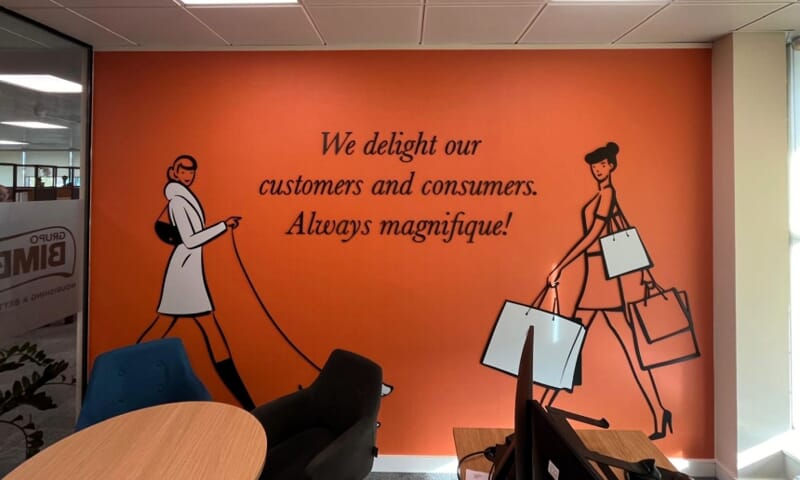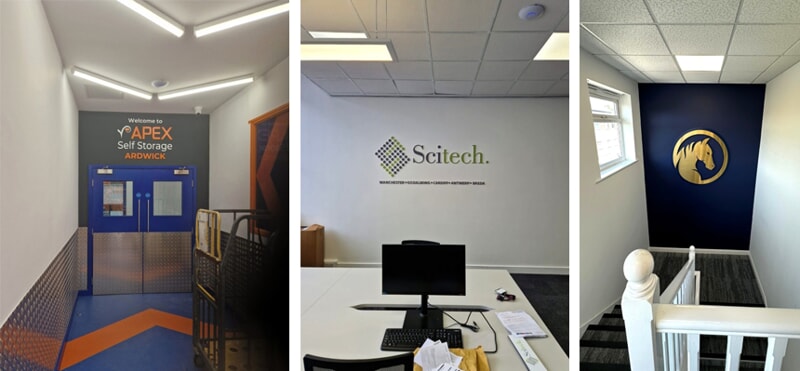Office signage plays a crucial role in shaping your workplace, improving navigation and reinforcing your brand identity for both your staff and visitors alike. Whether in your headquarters, co-working spaces or client-facing offices, effective signage enhances professionalism and functionality. From wayfinding to regulatory compliance, understanding the various types of office signage helps businesses make informed decisions about what will best suit your business’s needs.

1. Reception and Lobby Signs
Your reception area is the first point of contact for visitors, making signage in this space particularly important. Reception signs typically display the company name, logo, and branding elements to establish a strong first impression. Materials such as acrylic, brushed metal, or illuminated lettering can add a premium feel, reinforcing a company’s professional image. Digital signage is also becoming popular here, allowing real-time updates, welcome messages or promotional content to be displayed.
2. Wayfinding and Directory Signs
Navigating a large office can be challenging, particularly for new employees, visitors and clients. Wayfinding signs help guide people efficiently, reducing frustration and improving their overall experience. Directory boards, often found at the entrance or reception, list departments, room numbers, and key members of your staff, directing visitors to the right destination. Internal wayfinding signage includes arrows, floor directories and colour-coded systems for ease of movement. Digital wayfinding solutions, such as touchscreen kiosks, offer interactive maps and dynamic updates.
3. Door and Office Nameplates
Individual office and meeting room signs provide clear identification of spaces within your workplace. These can range from simple engraved plaques to interchangeable nameplates that allow for easy updates as staff members or office layouts change. We can help you integrate your branding into these signs by using corporate colours or logos to maintain consistency throughout. For privacy-sensitive areas, frosted glass decals or sliding ‘Occupied/Vacant’ indicators can be highly effective.
4. Health and Safety Signage
Ensuring compliance with workplace safety regulations is a legal requirement, and signage plays a key role in maintaining a safe environment. Mandatory signs include fire exit directions, first aid locations, and hazard warnings. In the UK, workplace safety signage must adhere to BS EN ISO 7010 standards, ensuring uniformity and clarity. These signs should be strategically placed where risks are most prevalent, such as near stairwells, kitchens, and machinery areas. Clear, well-maintained safety signage helps reduce accidents and ensures that your business complies with all relevant health and safety laws.
5. Branding and Motivational Signage
Venturing beyond functionality, office signage can also contribute to your workplace culture. Branded signage, such as wall decals with company values or mission statements, reinforces corporate identity and fosters a sense of belonging among your employees. Motivational quotes, vision statements, or creative graphics can enhance productivity, particularly in open-plan offices or communal spaces by helping to create an inspiring environment in which to work.

6. Digital and Interactive Signage
Technology-driven signage is becoming increasingly popular in modern offices. Digital screens offer versatility, allowing your company to update content frequently without the need to reprint static signs. Common uses include real-time announcements, meeting room booking displays and live performance dashboards. Touchscreen signage can provide interactive maps, check-in systems or issue visitor registration portals to streamline your operations and create a great impression on visitors and clients.
7. Accessibility and Inclusive Signage
An inclusive workplace should cater to the needs of all your employees and visitors, including those with disabilities. Accessible signage includes features such as braille, tactile lettering and high-contrast colours for those with visual impairments. Under the Equality Act 2010, UK businesses must make reasonable adjustments to accommodate disabled individuals, including appropriate signage that aids navigation and understanding. Installing hearing loop indicators, wheelchair-accessible route markers, and large-format text signs ensures that your workplaces is inclusive and legally compliant.
8. Temporary and Event Signage
Offices often require temporary signage for events, meetings or reconfiguration of space. Portable stands, retractable banners and adhesive vinyl graphics offer flexible solutions that can be installed and removed easily. Whether promoting an internal initiative or guiding attendees at a corporate event, temporary signage provides clarity without long-term commitment. Reusable options, such as whiteboard signs or digital displays, allow your business to adapt your messaging as needed.

Making the Right Signage Choices
Selecting the right mix of office signage depends on your own business’s specific needs and space constraints. A combination of permanent and digital solutions will help to ensure long-term functionality and flexibility.
At FASTSIGNS® Manchester, we can help tailor solutions reflect your company’s brand identity, meet regulatory requirements and enhance your workplace culture. Investment in high-quality office signage will allow your business to create an environment that is not only visually appealing but also practical, professional and fully compliant.
